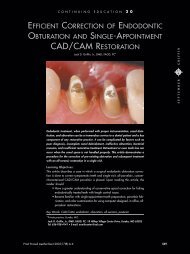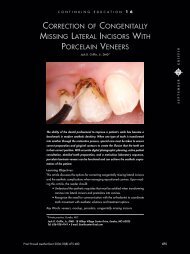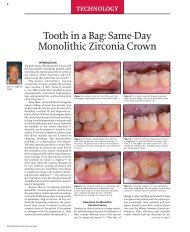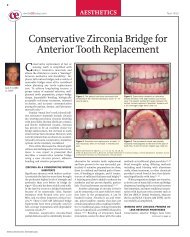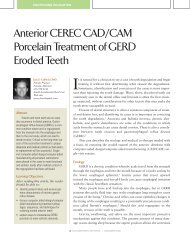Surface Treatments for Zirconia Bonding: A Clinical Perspective
Surface Treatments for Zirconia Bonding: A Clinical Perspective
Surface Treatments for Zirconia Bonding: A Clinical Perspective
- No tags were found...
You also want an ePaper? Increase the reach of your titles
YUMPU automatically turns print PDFs into web optimized ePapers that Google loves.
ESTHETIC DENTISTRY / DENTISTERIE ESTHÉTIQUE<strong>Surface</strong> <strong>Treatments</strong> <strong>for</strong><strong>Zirconia</strong> <strong>Bonding</strong>: A <strong>Clinical</strong><strong>Perspective</strong>Jack D. Griffin Jr., DMD, Byoung In Suh, PhD, Liang Chen, PhD, Douglas J. Brown, DDS, FAGDAbout the AuthorsDr. Jack Griffin Jr. is in private practice in Eureka, Montana.Dr. Byoung Suh is the president of Bisco Inc. He founded the companyin 1981 and continues to conduct research in dental materials. Inaddition, he lectures extensively in the United States and Canada, andhas given over 200 lectures at various dental associations and researchconventions around the world.Dr. Liang Chen received his PhD degree from Tulane UniversityDepartment of Chemistry in 2005. Following graduation, Dr. Chenbecame a postdoctoral researcher in the area of organometallic andorganic chemistry at Stan<strong>for</strong>d University. In 2006 he became a researchassociate at Louisiana State University Dental School, where he and hisco-workers invented novel fluoride-releasing/recharging dentalmonomers/materials (metal-fluoride chelating dental monomers). Since2008 he has been working with Bisco Inc. as a research scientist.Dr. Douglas Brown is the senior manager of clinical affairs at Bisco Inc.A 1984 graduate of the University of Michigan School of Dentistry, heestablished his practice in Kalamazoo, Michigan. Dr. Brown has beeninvolved in the creation and implementation of numerous dentalproducts, including composites, glass ionomers, resin cements, andadhesives, and their incorporation into minimally invasive dentistry.He received his fellowship in the Academy of General Dentistry in2009. Dr. Brown can be reached at dbrown@bisco.com.Winter 2010Canadian Journal of Restorative Dentistry and Prosthodontics 23
SURFACE TREATMENTS FOR ZIRCONIA BONDING: A CLINICAL PERSPECTIVEABSTRACTThere has been a monumental shift in the use of zirconia in esthetic/restorative dentistry.<strong>Zirconia</strong>-based restorative materials exhibit improved strength, versatility of clinicalindications, and the ability to be CAD/CAM milled. They are also an alternative to theincreasingly higher cost of precious metals. As well, the creation of surface adhesiveprimers that create covalent bonding to zirconia will only help to propagate zirconia’s usein clinical dentistry.RÉSUMÉIl y a eu un changement monumental dans l’utilisation de la zircone (oxyde de zirconium)en dentisterie esthétique ou de restauration. Les matériaux de restauration à base dezircone possèdent une résistance améliorée et une versatilité des indications cliniques etpeuvent être utilisés avec la technologie CAO/FAO. Ce sont également une solution derechange aux métaux précieux dont le prix ne cesse d’augmenter. De plus, la création decouches adhésives superficielles favorisant une fixation par liaison covalente à la zirconepermettra de propager l’utilisation de la zircone en dentisterie clinique.<strong>Zirconia</strong> (ZrO 2 ) is a silica-free, acidresistant,polycrystalline ceramic thatdoes not contain amorphous silica (SiO 2 )glass. Traditional ceramic surface treatments(such as hydrofluoric acid [HF] etchingand/or silane primer application) areineffective on the silica-free surfaces ofzirconia, alumina, and metal. New researchhas shown phosphate monomers to have asignificant affinity <strong>for</strong> non-silica-based oxidessuch as zirconia. Research has shown that thecombination of light air abrasion andmethacryloyloxydecyl dihydrogen phosphate(MDP)-based zirconia primers is necessary toachieve long-term durable bonding tozirconia. It is imperative <strong>for</strong> the clinician tooptimize adhesive per<strong>for</strong>mance in less-thanretentivepreparation designs with the use ofetch-and-rinse (total etch) or etch-and-dry(self-etch) adhesives onto dentin, such as AllBond 3 or All Bond SE (Bisco, Schaumburg,IL); MDP-containing primers onto thezirconia indirect substrate, such as Z-PRIMEPLUS (Bisco); and dual-cure resin cementssuch as DuoLink or DuoLink SE (Bisco).When preparation designs are fully retentive(and strong adhesion is not critical),organophosphate-containing, self-adhesive,dual-cured resin cements, such as BisCem(Bisco), Maxcem Elite (Kerr, Orange, CA),and RelyX Unicem (3M ESPE, St. Paul, MN),can be used.The incorporation of proven monomers intonew product innovation aimed at addressingclinical challenges is exciting. The use ofprimers to enhance bonding to zirconia hasled to the development of improved materialalternatives in metal-free esthetic restorativedentistry.Treating the <strong>Zirconia</strong> <strong>Surface</strong>: Low-Pressure Al2O3 and <strong>Zirconia</strong> PrimersThe goal of replicating the cohesivehydrophobic interface (dentin-enameljunction, or DEJ) with the use of resin lutingcements is first dependent upon the clinicianaddressing the individual needs of the toothsubstrates (dentin, enamel) and the indirectsubstrates (zirconia, alumina, ceramic,metal). Adhesive bonding agents onto thetooth substrate and primers onto the indirectsubstrate are critical in optimizing thiscohesion.<strong>Zirconia</strong> has been used in clinical dentistry<strong>for</strong> several years with much success. 1–8Creating adhesion to non-silica-based oxideceramics such as zirconia, alumina, and metalwas the challenge that limited their use. 9–14This is changing with our currentunderstanding of zirconia. <strong>Zirconia</strong> is a silicafree,acid-resistant, polycrystalline ceramic. Itdoes not contain amorphous silica glass (likefeldspathic porcelain, leucite-rein<strong>for</strong>cedceramics, and lithium disilicate ceramics);thus, traditional ceramic surface treatmentssuch as HF etching followed by silaneapplication are ineffective. 9–14It is now understood that the combination oflow-pressure Al2O3 with primers specific tozirconia may contribute to long-term stabilityof its bonding. The use of pyro-chemical(Pyrosil, Sura Instruments, Jena,Germany) 15,16 or tribo-chemical treatments(Cojet/Rocatec, 3M ESPE) 12,14,17–22 to create apseudo-silane attached surface is analternative method. Internal research at BiscoDental Products with tribo-chemical bonding(Cojet/Rocatec) showed that it did not offerimproved bonding and could be prone todegradation. Other research has shown thattribo-chemical bonding improved bonding24 Journal canadien de dentisterie restauratrice et de prosthodontie Hiver 2010
GRIFFIN ET AL.Strong Bond Strength to Different Substratewith Z-Prime Plus<strong>Zirconia</strong>with no primer4 MPaCement-Self Cured23 MPaAlumina3 MPa18 MPaTitaniumOptionStainless SteelGold22 MPa23 MPa24 MPa20 MPaFigure 1. Shear bond strengths (SBSs) of different primers on etched lithiumdisilicates be<strong>for</strong>e and after accelerated aging (internal Bisco data).Composite27 MPaFigure 2. Bond strengths of Z-PRIME PLUS to varioussubstrates.with the use of primers. 19 Internal studies atBisco have shown Z-PRIME PLUS adhesiondoes not require mechanical altering of thezirconia surface.Phosphate Monomers Specific to<strong>Zirconia</strong>There are five commercial ceramic primersystems intended <strong>for</strong> use with zirconia: AZPrimer (Shofu Dental Corporation, SanMarcos, CA), Clearfil Ceramic Primer(Kuraray America, Houston, TX),Metal/<strong>Zirconia</strong> Primer (Ivoclar Vivadent,Amherst, NY), Monobond Plus (IvoclarVivadent), and Z-PRIME PLUS. Theseproducts differ in the type and concentrationof phosphate monomers used, clinicaltechnique <strong>for</strong> use, time of application, andproprietary <strong>for</strong>mulas. Phosphate monomers<strong>for</strong>m chemical bonds with the zirconiasurface and have resin terminal ends thatbond to the resin cements. MDP is the mosttime-tested of the commonly used phosphatemonomers and has been shown to have aspecial affinity <strong>for</strong> non-glass-based substratesof zirconia, alumina, and metal. MDP is arelatively hydrophobic monomer due to its10-carbon chain and contains both ahydrophilic phosphate terminal end thatchemically adheres to zirconia and apolymerizable methacrylate terminal end thatadheres to resin.Bond strengths are a function of the mode ofcuring, stability of the resin chemistry,compatibility of primer to cement, andcontamination potential dependent uponclinical application times. The acidic natureof phosphate monomers does pose a chemicalchallenge with creating <strong>for</strong>mulas that are bothdurable and stable. Monobond Plus andClearfil Ceramic Primer incorporate silanewith the intended additional use on silicabasedsurfaces. Silane is known to beunstable in acidic environments (Figure 1).The acidic nature of organophosphates(phosphate/phosphonate monomers) placedin products such as Monobond Plus andClearfil Ceramic Primer may lead toinstability of the silane component of theseindividual <strong>for</strong>mulas. Z-PRIME PLUS doesnot contain silane.Z-PRIME PLUS contains a propriety <strong>for</strong>mulaof concentrated MDP and carboxylicmonomers <strong>for</strong>mulated specific to zirconia,alumina, and metal. The versatility of theseprimers is a compelling feature <strong>for</strong> use onmany different indirect substrates (Figure 2).Adherence of Resin Cements to<strong>Zirconia</strong>: The SciencePhosphate monomers in self-adhesivecements are proven to be effective in adheringto non-silica-based polycrystalline materialsof zirconia, alumina, and metal. 17–20 It is withthis in<strong>for</strong>mation that primers specific tozirconia, alumina, and metal were created.Numerous research studies have shown thatphosphate /phosphonate monomers are veryeffective in improving zirconia bonding. Intheory, phosphate monomers <strong>for</strong>m chemicalbonds with the zirconia, alumina, and metaloxide surfaces and have resin terminal endgroups, which enable cohesive bonding toappropriate resin cements (Figure 3). 22,23Figure 3. Demonstration of how the hydrogen (-H)group of a phosphate monomer interacts with theZr-O group of zirconia to <strong>for</strong>m a phosphatemonolayer on the zirconia surface.<strong>Bonding</strong> <strong>Zirconia</strong> to Preparations withRetention/Resistance FormSelf-adhesive resin cements, such as BisCem,Maxcem Elite, and RelyX Unicem, are dualcured,contain organophosphate monomers,and can be used when preparation designs arefully retentive; however, these cements arehydrophilic due to the acidic resincomponents and have lower physical andmechanical properties than resin cements.Self-adhesive resin cements differ in viscosityWinter 2010 Canadian Journal of Restorative Dentistry and Prosthodontics 25
SURFACE TREATMENTS FOR ZIRCONIA BONDING: A CLINICAL PERSPECTIVETable 1. Shear bond strengths (MPa) of self-adhesive resin cements to zirconiaLight-Cured CementSelf-Cured Cement<strong>Zirconia</strong> <strong>Bonding</strong> Systems Initial*: 37°C/2 h Aging*: 100°C/3 d Initial*: 37°C/2 h Aging*: 100°C/3 dBisCem 20.0 (3.6) 1, bc 12.1 (2.8) 2, b 12.4 (2.6) 1, b 9.6 (2.4)2, bRelyX Unicem 11.6 (6.2) 1, d 4.2 (2.9) 2, c 6.2 (2.6) 1, c 2.7 (2.0) 2, cSmartCem2 16.2 (3.7) 1, cd 5.5 (1.9) 2, c 10.8 (3.0) 1, b 3.8 (1.8)2, cZ-PRIME PLUS/DuoLink 28.7 (5.7) 1, a 28.3 (4.4) 1, a 23.0 (5.3) 1, a 15.8 (2.7) 2, a*Means and standard deviations (n = 8) of shear bond strengths (MPa) tested on sandblasted zirconia using the Ultradent jig method.Results with the same numerical superscripts in the same row and same curing mode or same letter superscripts in the same columnare statistically the same (p > .05) (internal Bisco data).Table 2. Shear bond strength (MPa) of resin cements to zirconiaLight-Cured CementSelf-Cured Cement<strong>Zirconia</strong> <strong>Bonding</strong> Systems Initial* 37°C/2 h Aging* 100°C/3 d Initial* 37°C/2 h Aging* 100°C/3 dAZ Primer/ResiCem 21.2 (8.3) 1, a 17.7 (5.5) 1, b 12.5 (5.9) 1, b 5.8 (1.9) 2, bClearfil Ceramic Primer/Panavia F2.0 7.5 (4.5) 1, b 3.2 (2.2) 2, c 8.9 (4.0) 1, b 1.7 (2.1) 2, cMonobond Plus/Multilink Automix 26.4 (8.8) 1, a 15.5 (5.4) 2, b 10.8 (3.3)1, b 6.7 (1.8) 2, bZ-PRIME PLUS/DuoLink 28.7 (5.7) 1, a 28.3 (4.4) 1, a 23.0 (5.3) 1, a 15.8 (2.7) 2, a*Means and standard deviations (n = 8) of shear bond strengths (MPa) tested on sandblasted zirconia using the Ultradent jig method.Results with the same numerical superscripts in the same row and same curing mode or same letter superscripts in the same columnare statistically the same (p > .05) (internal Bisco data).(efficiency of mix) and self-cure chemistry(polymerization conversion, setting times).These properties are significantly affectedwith aging, depending upon the brand. Bondstrengths of self-adhesive cements are lowerthan those of bonded resin cements to bothdentin and zirconia; but in retentivepreparations, the ease of placement is acompelling benefit (Table 1).Comparison of <strong>Zirconia</strong> Restoration Methods:SBS on <strong>Zirconia</strong>Rely X Luting+(3MESPE)FujiCEM (GC)SmartCem2(Dentsply)Bis Cem (Bisco)UniCem (3M ESPE)Z-Prime Plusw/ Duolink (Bisco)Duolink (Bisco)Glass Ionomer Cement4 MPa8 MPaSelf-Adhesive Cement11 MPa6 MPaPrimer w/ Resin Cement12 MPaCement-Self Cured23 MPaTraditional Resin Cement without Primer (Control)4 MPaFigure 4. Comparison of shear bond strengths(SBSs) with various zirconia restoration methods.Self-adhesive resin cements may not be strongenough to be used alone on both surfaces(tooth and zirconia) when cementing a nonretentivezirconia restoration. Primers shouldbe part of the clinician’s protocol to play abeneficial role <strong>for</strong> improved adhesion of selfadhesivecements to zirconia. Glass ionomercements have minimal bond strengths tozirconia (4 MPa) and are susceptible to waterdegradation due to their chemistry 24–27 (Figure 4).Creating Adhesion between Direct andIndirect Substrates When Retention Isa ChallengeFor slightly retentive or non-retentive designs,traditional adhesive protocols are time testedand required. Optimizing adhesiveper<strong>for</strong>mance is the goal in less-than-retentivepreparation designs and demands the use ofdentin adhesives including self-etch (ACE/AllBond SE, Bisco) or total etch (All Bond 3)primers specific to zirconia/metal (Z-PRIMEPLUS) and the use of dual-cure hydrophobicresin cements (DuoLink).Primers that address the specific needs ofnon-silica oxides (zirconia, alumina, andmetal) are highly beneficial and warranted <strong>for</strong>the restorations when retention/resistance<strong>for</strong>m is compromised. Ceramic and metalprimers have been shown to be important tothe success of bonding to these indirectmaterials in laboratory testing. <strong>Clinical</strong>experience with primers has indicatedimproved bonding to both direct and indirectsubstrates. The self-cure mode has beenshown to significantly affect bond strengths(Table 2).The Final Link: All Resin Cements AreNot Created EqualArguably, the most important factor inbonding to zirconia is the polymerization(setting) properties of resin cements. The selfcuremodes of dual-cure cements are the linkto optimizing adhesion between the toothsubstrate and indirect restoration. To thisdate, most zirconia, alumina, and metalindirect restorations lack the ability totransmit the light required <strong>for</strong> properpolymerization of resin cements. The dualcuredmode is preferred over light-cured-onlyesthetic resin cements, removing the potential<strong>for</strong> limited light transmission through opaquecopings.It is important to note that all dual-curedcements are not created equal. Choose a dualcuredcement that per<strong>for</strong>ms equally well inboth light-cured and self-cured modes, is notaffected by aging (ask the manufacturer whenthe catalyst and base were made, not whenthey expire), and has an appropriate settingtime. Resin cement that fully polymerizes inthe self-cured mode within 6 minutes allows<strong>for</strong> interproximal flossing, whereas one that26 Journal canadien de dentisterie restauratrice et de prosthodontie Hiver 2010
GRIFFIN ET AL.Case ReportPresentationFigure 5. Comparison of shear bond strengths (SBSs) using corresponding brands (Z-PRIMEPLUS/DuoLink, AZ Primer/ResiCem, Clearfil Ceramic Primer/Panavia F2.0, Monobond Plus/MultilinkAutomix, Metal Zr Primer/Multilink Automix) (internal Bisco data).A 58-year-old female (a breast cancersurvivor of 5+ years) presented to ourpractice. She had a retained deciduous tooth“h” with a mesio-angular impacted tooth #23extending under teeth #21 through #24(Figure 7) and was concerned about thedarkening of this cuspid in addition toconservative enhancement of her smile(Figure 8). A comprehensive list of treatmentoptions was discussed, including orthodonticrepositioning. The accepted plan was <strong>for</strong>the extraction of tooth h, a zirconiaframework/porcelain bridge to replace #23, acomposite to correct the facial incisal of #21,and a composite on #13 to restore the cusp tipand to provide cuspid disclusion in excursivemovements.Preparation and DesignThe laboratory prescription was <strong>for</strong> a zirconiaframework bridge with add-on porcelain overan ovate pontic design (Figures 9 to 12).<strong>Zirconia</strong> has been widely used the past fewyears as a bridge framework because of itsnon-metalic colour, fracture resistance withflexural tests over 1,000 MPa, and excellentlong-term clinical success. A majordisadvantage of its use was the inability toFigure 6. Shear bond strengths (SBSs) of Z-PRIME PLUS with various cements(internal Bisco data).Figure 7. Lateral view of greying deciduous cuspid.sets in 10 to 12 minutes requires appropriatemeasures not to interfere with thedevelopment of the bond. Internal testing atBisco Dental Products supports previous datashowing that self-cured modes of some resincements significantly differ and many arefurther affected by aging of the chemistry(Figure 5).Internal testing at Bisco has shown Z-PRIMEPLUS to significantly improve the self-cureefficiencies of competitive brands of resincements. It is theorized that the proprietarycombination of monomers addresses acidityissues inherent within many <strong>for</strong>mulas(Figure 6).Figure 8. Maxillary anterior pre-treatment display.Winter 2010 Canadian Journal of Restorative Dentistry and Prosthodontics 27
SURFACE TREATMENTS FOR ZIRCONIA BONDING: A CLINICAL PERSPECTIVEFigure 9. Pep Gen granular and flow graft materialswere placed and a collagen membrane sutured inplace <strong>for</strong> stabilization.Figure 10. Conservative preparation designs withminimal reduction, rounded shoulders, and seatinggrooves parallel in nature.Figure 11. <strong>Zirconia</strong> framework overlayed withCeram porcelain.Figure 12. Our reputation is built on adhesion.Figure 13. Ten-second application of Z-PRIMEPLUS, which would be followed by air-drying.Figure 14. Maxillary anterior view of restoration.bond zirconia to the tooth substrate. Ourimproved knowledge of non-glass-basedoxides such as zirconia has resulted in thesubsequent innovation of adhesives withspecial qualities. Z-PRIME PLUS is one ofthose special primers that have been shownto significantly increase bond strengths tozirconia allowing <strong>for</strong> more conservativeremoval of tooth tissue.Treatment CompletionFollowing verification of the fit, the bridgewas cleaned in an ethyl alcohol ultrasonicbath <strong>for</strong> 10 minutes. Two drops of zirconiaprimer (Z-PRIME) were placed on theinternal surface of the porcelain abutmentsand dried after 10 seconds (Figure 13). It wasmy decision to optimize adhesion with theuse of total etch on dentin/enamel, coupledwith the use of a hydrophobic dual-cure resincement.The abutments were cleaned with slurry ofpumice/water. The etch-and-rinse techniquewas accomplished using phosphoric acid(UNI-ETCH BAC, Bisco) followed bydisinfecting/rewetting with a cavity cleanserCHX and an application of All Bond 3primer/resin. DuoLink dual-cure resincement was placed directly on the teeth, andthe bridge was positioned with moderatedigital pressure. Clean-up was initiallyaccomplished using a microbrush and 2 × 2cotton gauze. Margins were initially lightcured;then the dual cure was allowed tocement to complete polymerization in selfcuremode. Final clean-up was accomplishedusing 204S scaler and explorer. Occlusion waschecked, cuspid disclusion verified, andanterior guidance was checked.Teeth #13 and #21 were prepared lightly usinga finishing diamond to remove old fillingmaterial, to make an irregular finish line, andto remove staining. The teeth were isolatedwith retractors (SeeMore, Discus Dental,Culver City, CA) and etched <strong>for</strong> 20 secondswith 37% phosphoric acid (UNI-ETCHBAC); subsequently, they were rinsed, andseveral coats of bonding agent (All Bond 3)were applied. Various layers of dentin,enamel, and incisal opacities of composite(Renamel, Cosmedent, Chicago, IL) wereapplied with Creative Color (Cosmedent)stain.The lingual and bulk of the tip on #13 werecompleted using Renamel UniversalFigure 15. A smile to be proud of.Microhybrid <strong>for</strong> strength, tinted with greyand honey yellow Creative Color and coveredfacially with Renamel Microfil IncisalMedium <strong>for</strong> polishability. Occlusion waschecked and cuspid disclusion on #6 wasconfirmed. Polishing was completed withFlexiDisk rubber polishers (Cosmedent).Tooth #21 was restored using RenamelMicrofil Incisal Medium, coupled withmatching tints. Shaping was completed withSofLex disks (3M) and polishing withFlexiDisk (Cosmedent) rubber polishers.A clear, vacuum-<strong>for</strong>med, 2 mm hard/softnocturnal bruxism splint was made(Erkodent, Glidewell Labs, Newport Beach,CA), and the patient was encouraged to wear28 Journal canadien de dentisterie restauratrice et de prosthodontie Hiver 2010
GRIFFIN ET AL.it nightly to prevent parafunctional <strong>for</strong>cesparticularly under times of stress.The final result was pleasing (Figures 14 and 15).ConclusionPatients demand esthetics. The incorporationof zirconia in clinical dentistry offers a newalternative to metal-free esthetic dentistry.New esthetic restorative materials demandadhesion. Recreating the DEJ is a function ofaddressing the needs of the individualsubstrates involved (enamel, dentin, andindirect materials such as zirconia). The useof adhesives on the tooth substrate and theuse of primers on the indirect substrate inconjunction with quality resin-based cementsare crucial in optimizing clinical outcomes tothese new restorative materials.DisclosureDr. Byoung Suh is the founder of BiscoDental. Dr. Liang Chen is a senior researcherat Bisco Dental. Dr. Douglas Brown is seniormanager of clinical affairs at Bisco Dental.Dr. Jack Griffin Jr. declares he has no financialinterest in the materials mentioned in thisarticle and is not receiving an honorarium <strong>for</strong>his contribution to this article. The contentprovided is based solely on his belief intranslating science to the application ofclinical dentistry.References1. Conrad HJ, Seong WJ, Pesun IJ. Currentceramic materials and systems withclinical recommendations: a systematicreview. J Prosthet Dent2007;98(5):389–404.2. Denry I, Kelly JR. State of the art ofzirconia <strong>for</strong> dental applications. DentMater 2008;24(3):299–307.3. Kelly JR, DenryI. Stabilized zirconia as astructural ceramic: an overview. DentMater 2008;24(3):289–98.4. Aboushelib MN, Kleverlaan CJ, FeilzerAJ. Microtensile bond strength ofdifferent components of core veneeredall-ceramic restorations. Part II: <strong>Zirconia</strong>veneering ceramics. Dent Mater2006;22(9):857–63.5. Blatz MB. Long-term clinical success ofall-ceramic posterior restorations.Quintessence Int 2002;33(6):415–26.6. Lopes GC, Baratieri LN, Caldeira deAndrada MA, Maia HP. All-ceramic postcore, and crown: technique and casereport. J Esthet Restor Dent2001;13(5):285–95.7. Meyenberg KH, Luthy H, Scharer P.<strong>Zirconia</strong> posts: a new all-ceramic concept<strong>for</strong> nonvital abutment teeth. J EsthetDent 1995;7(2):73–80.8. Piconi C, Maccauro G. <strong>Zirconia</strong> as aceramic biomaterial. Biomaterials1999;20(1):1–25.9. Blatz MB, Sadan A, Kern M. Resinceramicbonding: a review of theliterature. J Prosthet Dent2003;89(3):268–74.10. Borges GA, Sophr AM, de Goes MF, et al.Effect of etching and airborne particleabrasion on the microstructure ofdifferent dental ceramics. J Prosthet Dent2003;89(5):479–88.11. Della Bona A, Anusavice KJ, Shen C.Microtensile strength of compositebonded to hot-pressed ceramics. J AdhesDent 2000;2(4):305–13.12. Derand P, Derand T. Bond strength ofluting cements to zirconium oxideceramics. Int J Prosthodont2000;13(2):131–5.13. Guazzato M, Proos K, Quach L, SwainMV. Strength, reliability and mode offracture of bilayered porcelain/zirconia(Y-TZP) dental ceramics. Biomaterials2004;25(20):5045–52.14. Ozcan M, Vallittu PK. Effect of surfaceconditioning methods on the bondstrength of luting cement to ceramics.Dent Mater 2003;19(8):725–31.15. Janda R, Roulet JF, Wulf M, Tiller HJ. Anew adhesive technology <strong>for</strong> allceramics.Dent Mater 2003;19(6):567–73.16. Ruttermann S, Fries L, Raab WH, JandaR. The effect of different bondingtechniques on ceramic/ resin shear bondstrength. J Adhes Dent 2008;10(3):197–203.17. Amaral R, Ozcan M, Valandro LF, et al.Effect of conditioning methods on themicrotensile bond strength of phosphatemonomer-based cement on zirconiaceramic in dry and aged conditions. JBiomed Mater Res B Appl Biomater2008;85(1):1–9.18. Ozcan M, Nijhuis H, Valandro LF. Effectof various surface conditioning methodson the adhesion of dual-cure resincement with MDP functional monomerto zirconia after thermal aging. DentMater J 2008;27(1):99–104.19. Tanaka R, Fujishima A, Shibata Y, et al.Cooperation of phosphate monomerand silica modification on zirconia. JDent Res 2008;87(7):666–70.20. Wegner SM, Kern M. Long-term resinbond strength to zirconia ceramic. JAdhes Dent 2000;2(2):139–47.21. Aboushelib MN, Matinlinna JP, SalamehZ, Ounsi H. Innovations in bonding tozirconia-based materials: Part I. DentMater 2008;24(9):1268–72.22. Yoshida K, Tsuo Y, Atsuta M. <strong>Bonding</strong> ofdual-cured resin cement to zirconiaceramic using phosphate acid estermonomer and zirconate coupler. JBiomed Mater Res B Appl Biomater2006;77(1):28–33.23. Kern M, Barloi A, Yang B. <strong>Surface</strong>conditioning influences zirconia ceramicbonding. J Dent Res 2009;88(9):817–22.24. Ernst CP, Cohnen U, Stender E,Willershausen B. In vitro retentivestrength of zirconium oxide ceramiccrowns using different luting agents. JProsthet Dent 2005;93(6):551–8.25. Marchan S, Coldero L, Whiting R,Barclay S. In vitro evaluation of theretention of zirconia-based ceramic postsluted with glass ionomer and resincements. Braz Dent J 2005;16(3):213–7.26. Uo M, Sjögren G, Sundh A, et al. Effectof surface condition of dental zirconiaceramic (Denzir) on bonding. DentMater J 2006;25(3):626–31.27. Gernhardt CR, Bekes K, Schaller HG.Short-term retentive values of zirconiumoxide posts cemented with glass ionomerand resin cement: an in vitro study and acase report. Quintessence Int2005;36(8):593–601Winter 2010 Canadian Journal of Restorative Dentistry and Prosthodontics 29



